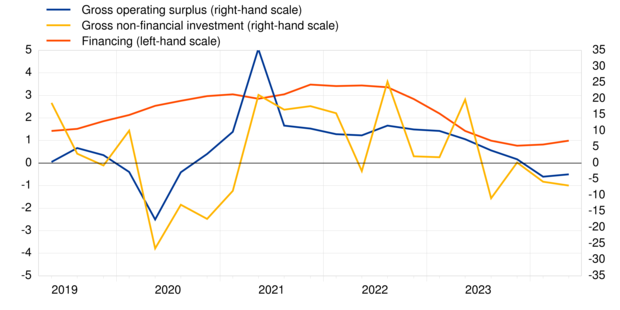Households and non-financial corporations in the euro area: second quarter of 2024
- STATISTICAL RELEASE
Households and non-financial corporations in the euro area: second quarter of 2024
4 October 2024
- Households' financial investment increased at higher annual rate of 2.1% in second quarter of 2024, after 1.9% in previous quarter
- Non-financial corporations' financing grew at higher annual rate of 1.0% (after 0.8%)
- Non-financial corporations' gross operating surplus decreased more slowly at annual rate of -3.5% (after -4.2%)
Chart 1
Household financing and financial and non-financial investment
(annual growth rates)

Chart 2
NFC gross-operating surplus, non-financial investment and financing
(annual growth rates)

Households
Household gross disposable income increased in second quarter of 2024 at a lower annual rate of 4.8%, after 6.1% in the first quarter of 2024. The compensation of employees grew at a lower rate of 5.5% (after 6.0%), and gross operating surplus and mixed income of the self-employed increased at a lower rate of 4.6% (after 5.9%). Household consumption expenditure grew at a lower rate of 3.1% (after 4.2%).
The household gross saving rate increased to 14.9% in the second quarter of 2024, compared with 14.5% in the previous quarter.
Household gross non-financial investment (which refers mainly to housing) decreased at a lower annual rate of -1.7% in the second quarter of 2024 (after -3.2% ). Loans to households, the main component of household financing, increased at an unchanged rate of 0.5%.
Household financial investment increased at a higher annual rate of 2.1% in the four quarters to the second quarter of 2024, after 1.9% in the four quarters to the first quarter of 2024. Among its components, currency and deposits grew at a higher rate of 2.3% (after 1.5%), while investment in debt securities increased at a lower rate (28.1% after 40.2%). Investment in shares and other equity grew at a higher rate of 0.3% (after 0.0%). This was due to unlisted shares and other equity decreasing more slowly (-0.3% after -0.9%), while investment fund shares grew at a broadly unchanged rate (1.9%). Investment in listed shares decreased faster (-0.9% after -0.6%). Life insurance decreased at a broadly unchanged rate (-0.2%) and pension schemes grew at a lower rate (2.2% after 2.4%).
Household net worth increased at an annual rate of 2.8% in the second quarter of 2024, after 2.1% in the previous quarter. Net financial and non-financial assets grew due to valuation gains in addition to investments. Housing wealth, the main component of non-financial assets, increased (0.5%) after decreasing in the previous quarter (-1.3%). The household debt-to-income ratio decreased to 83.1% in the second quarter of 2024 from 87.5% in the second quarter of 2023.
Non-financial corporations
Net value added by NFCs grew at a higher annual rate of 1.6% in the second quarter of 2024 (after 1.2% in the previous quarter). The negative growth rate of gross operating surplus decreased (-3.5% after -4.2%), while the growth rate of net property income - defined in this context as property income receivable minus interest and rent payable - increased (4.2% after 0.7%). As a result gross entrepreneurial income (broadly equivalent to cash flow) decreased at a lower rate of -1.3% (after -3.7%).[1]
NFCs’ gross non-financial investment decreased at a faster annual rate of -7.0% (after -5.8% in the previous quarter).[2] NFCs’ financial investment grew at a higher rate of 2.2% (after 1.9%) in the four quarters to the second quarter of 2024. Among its components, currency and deposits grew at a higher rate (2.5% after 0.4%), while loans granted increased at a lower rate (3.8% after 4.2%). Investment in shares and other equity grew at an unchanged rate of 1.6%.
Financing of NFCs increased at a higher annual rate of 1.0% (after 0.8%), as financing via debt securities (3.1% after 2.2%), shares and other equity (0.8% after 0.4%) and trade credits (2.1% after 0.4%) all grew at higher rates. Loan financing grew at a lower rate of 0.8% (after 1.2%).[3]
NFCs’ debt-to-GDP ratio (consolidated measure) decreased to 66.7% in the second quarter of 2024, from 69.2% in the same quarter of the previous year; the non-consolidated, wider debt measure decreased to 128.2% from 131.3%.
For queries, please use the Statistical information request form.
Notes
- This statistical release incorporates revisions to the data since the first quarter of 2020.
- Revisions of the entire time series may be more pronounced in this and the following release as in 2024 EU countries implement a benchmark revision in national accounts statistics. For further information see also: https://ec.europa.eu/eurostat/web/esa-2010/data-revision.
- The annual growth rate of non-financial transactions and of outstanding assets and liabilities (stocks) is calculated as the percentage change between the value for a given quarter and that value recorded four quarters earlier. The annual growth rates used for financial transactions refer to the total value of transactions during the year in relation to the outstanding stock a year before.
- The euro area and national financial accounts data of non-financial corporations and households are available in an interactive dashboard.
- Hyperlinks in the main body of the statistical release are dynamic. The data they lead to may therefore change with subsequent data releases as a result of revisions. Figures shown in annex tables are a snapshot of the data as at the time of the current release.
- The ECB publishes experimental Distributional Wealth Accounts (DWA), which provide additional breakdowns for the household sector. The release of results for 2024 Q2 is planned for 29 November 2024 (tentative date).
-
Gross entrepreneurial income is the sum of gross operating surplus and property income receivable minus interest and rent payable.
-
Gross non-financial investment is the sum of gross fixed capital formation, changes of inventories, and the net acquisition of valuables and non-produced assets (e.g. licences, land).
-
Loan financing comprises loans granted by all euro area sectors (in particular MFIs, non-MFI financial institutions and loans from other non-financial corporations) and by creditors that are not resident in the euro area.
Poslední zprávy z rubriky Makroekonomika:
Přečtěte si také:
Prezentace
02.10.2024 Inflace nezmizí. I 2,2 % vás v čase může…
26.09.2024 Technologický gigant Intel na kolenou! Co…
24.09.2024 XTB představuje Zlatana Ibrahimoviće jako…
Okénko investora

Ali Daylami, BITmarkets
Trump vs. Harris: komu majitelé kryptoměn coby voliči dají radši hlas?

Radoslav Jusko, Ronda Invest

Petr Lajsek, Purple Trading

Mgr. Timur Barotov, BHS

Miroslav Novák, AKCENTA
Utlumená aktivita v tuzemském výrobním sektoru pokračuje – PMI (září 2024)

Olívia Lacenová, Wonderinterest Trading Ltd.
Ocelářská krize v Číně: Ceny železné rudy čelí prudkému oslabení

Jakub Petruška, Zlaťáky.cz

Jiří Cimpel, Cimpel & Partneři


